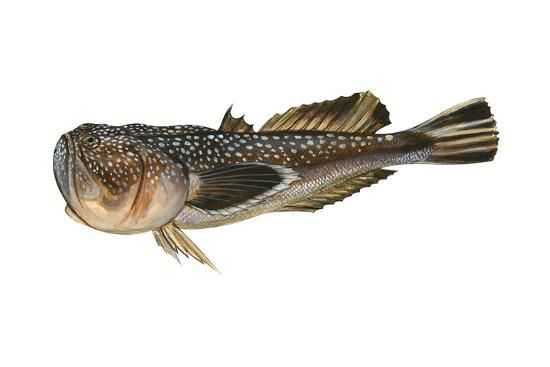Northern Stargazer

Species Details
Astroscopus Guttatus
Uranoscopidae
Perciformes
Onshore, Oceanfloor, Sandy
6 - 13 lbs.
8" - 23"
Northern Stargazer (Astroscopus guttatus) Fish Description
Also known as popeye fish, and tube-nosed stargazer, the Northern Stargazers look quite strange and very distinct with their large heads, flat foreheads, and speckled flat bodies. Their nostrils, gill slits, eyes, and most of their mouth are found on top of their bodies. Their bodies are usually blackish-brown in color and evenly freckled with white spots from their heads to their tails. They have three horizontal stripes on their white tails. Their remarkable pectoral fins are very useful in digging and burying into the sand.
The Northern Stargazer highly resembles the Southern Stargazer (Astrospocus y-graecum). To tell them apart, one must look at the middle stripe on the tail. This stripe extends onto the rear portion of the body of Northern Stargazers but this does not go beyond the tail in the case of southern stargazers.
Northern Stargazer Diet and Size
Northern Stargazers feed on small benthic fish and crustaceans like crabs and shrimps. They wait for their prey while they are buried in the sand with only their mouth and eyes sticking out. Northern Stargazers suck their prey by using their large mouths to create a vacuum.
Northern Stargazers can grow up to 22 inches in length; on average, they measure from 8 to 18 inches. They can weigh up to 20 pounds.
Interesting Facts About the Northern Stargazer
- Northern Stargazers have an organ on their heads that can create an electric charge (up to 50 volts) that may stun their prey and discourage their predators. This electric organ develops when juvenile Northern Stargazers mature into adults. Marine bony fishes like the Northern Stargazers which possess this ability are described as bioelectrogenetic.
- Due to their ability to electrocute other fishes and eat them alive by camouflaging themselves before attacking, Northern Stargazers are dubbed as “the meanest fish in creation”.
- Astrocopus means ‘one who aims at the stars’, while guttatus means ‘speckled’ — referring to the white spots on their backs. The Northern Stargazers’ eyes are situated on top of their heads (poking through the sand when they burrow their bodies), thus the name stargazer.
- Northern Stargazers use their side fins to burrow in the sand in a matter of seconds.
- Charles Abbott first described the Northern Stargazer in 1860.
- Northern Stargazers breathe through their nostrils unlike most species of fish which bring water in through their mouths for respiration.
Northern Stargazers — Fishing Techniques
Because of the Northern Stargazers’ ability to produce electric currents, anglers must handle them with caution. They are not listed as Endangered or Vulnerable by the IUCN. They can be fished all-year round. Anglers usually catch them by mistake when fishing for other species.
To lure Northern Stargazers, anglers can use squid strips, cut pieces of fish, or pieces of crab meat on bottom rigs.
Northern Stargazers Habitat and Distribution
Northern Stargazers are demersal so they like the sandy bottoms of open waters as deep as 120 feet. Due to their benthic nature, Northern Stargazers spawn on the bottom areas of the sea during late spring until the early months of summer.
They are found mostly along the eastern seaboard of the U.S. as well as in the lower Chesapeake Bay (they move to the upper part of the bay during autumn). They also abound the waters in the Atlantic Coast between New York and North Carolina.







